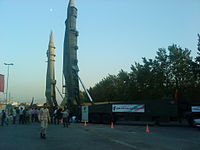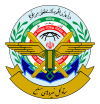Sejjil
| Sejil-1/2/3 | |
|---|---|
 | |
| Type | Precision-guided hypersonic Strategic MRBM |
| Service history | |
| In service | In service as of 2014 |
| Used by | Iran |
| Production history | |
| Manufacturer | Iran |
| Specifications | |
| Mass | 22.5 tonnes[1] |
| Length | 18.2 m[1] |
| Diameter | 1.25 m[1] |
| Warhead | 500-1500 kg[2] |
| Propellant | Solid fuel |
Operational range | 2000[3]-2500 km[1][4] (Hybrid mode 4500) |
| Maximum speed | Mach 14 (4300 m/s)[citation needed] |
Guidance system | Inertial - GPS[citation needed] |
| Accuracy | 20 m |
Sejil, or Sejjil, (Persian: سجیل, a Quranic word meaning "baked clay", see Surat al-Fil) is a family of Iranian solid-fueled medium range ballistic missiles. The Sejil are replacements for the Shahab liquid-fueled ballistic missiles. According to US Pentagon sources, the missile profile of the Sejil closely matches those of the Ashura, Ghadr-110 and the Samen.[5] The last test flight occurred in 2011.[6]
Design
According to Jane's Information Group, details of the design other than the number of stages and that it uses solid fuel have not been released. Uzi Rubin, former director of Israel's Ballistic Missile Defense Organization, indicated that, "Unlike other Iranian missiles, the Sajil bears no resemblance to any North Korean, Russian, Chinese or Pakistani (missile technology). It demonstrates a significant leap in Iran's missile capabilities." Rubin went on to state that the Sejil-1 " ... places Iran in the realm of multiple-stage missiles, which means that they are on the way to having intercontinental ballistic missile (ICBM) capabilities ..."[7]
The missile utilizes composite solid fuel and unlike the Shahab-3 medium-range ballistic missile (MRBM), which is launched only vertically, the Sejil could be launched at a variable angle.[8]
As a weapon, Sejil presents much more challenge to Iran's potential enemies, as solid-fuel missiles can be launched with much less notice than liquid-fueled missiles, making them more difficult to strike prior to launch.[9]
Political commentator Kiyan Nader Mokhtari elaborated more about the features of the new missile. "The engine and various fuels have been tested and the platform is now highly reliable. The latest tests to be carried out are mainly to do with the variety of warheads that it has to carry," he said. "Some of the warheads obviously have been designed to be able to evade anti-ballistic missile defenses of the enemy in actual battle conditions," he added.[10]
Variants
- Sejil-1: The Sejil is a two-stage, solid-propellant, surface-to-surface missile (SSM) produced by Iran with a reported 2,400 km (1,500 mi) range. A successful test launch took place on 13 November 2008.[11] Its range, if confirmed, would allow it to strike targets as far away as Israel and southeastern Europe, though Iran asserts that it is intended for purely defensive purposes.
- Sejil-2: Sejil-2 is an upgraded version of the Sejil.[1] The Sejil-2 two-stage solid-fuel missile has a 2,000 km range and was first test-fired on 20 May 2009.[12] The Sejil-2 surface-to-surface medium-range ballistic missile (MRBM) was first tested eight months prior to the actual test launch, which took place in the central Iranian province of Semnan.[13] Improvements include better navigation system, better targeting system, more payload, longer range, faster lift-off, longer storage time, quicker launch and lower detection possibility.[14] On December 16, 2009,an upgraded version of Sejil-2 was test fired.[15] This new version of the Sejil-2 is faster during the powered flight portion of its trajectory and also during the re-entry phase.It is also harder to detect for anti-missile systems, as it is covered with anti-radar material.The new highly maneuverable missile is also more efficient as it requires less time for prelaunch preparations.[10]
- Sejil-3: An unconfirmed report stated the a Sejil-3 may be in development. The Sejil-3 would reportedly have three stages, a maximum range of 4,000 km, and a launch weight of 38,000 kg.[2] The Sejil-3 is intended to be the first IRBM of the Sejil series.It is based on the design of the Sejil-2, but with an improved engine and guidance system and better survivability. The Sejil-3 is more maneuverable than its predecessor, making it harder for ABM systems to intercept. The final phase of testing is due to commence in early 2016, with entry into service by 2017.
- Sejil-2 missile images
-
Second Sejil missile launch, 2009-05-20
-
Sejil-2 missile on assembly dollies at factory
-
Sejil-2 (right) and Qiam (left) missile
See also
External links
References
- ^ a b c d e f Theodore Postol (31 May 2009). The Sejil Ballistic Missile (PDF) (Report). Massachusetts Institute of Technology. Archived from the original (PDF) on 3 February 2013. Retrieved 14 September 2012.
- ^ a b https://missilethreat.csis.org/missile/sejjil
- ^ BALLISTIC AND CRUISE MISSILE THREAT nasic.af.mil
- ^ Sajjil/Ghadr-110 globalsecurity.org
- ^ a b "Iran Tests Second Solid-Fuelled Sejil Missile, Capable of 2,900 km". Defense Update. 2009-05-20. Archived from the original on 2009-05-23. Retrieved 2009-05-21.
- ^ http://afpc.org/publication_listings/viewPolicyPaper/3767[permanent dead link]
- ^ "New missile marks 'significant leap' for Iran capabilities". Jane's Defence Weekly. 2008-11-14. Retrieved 2010-04-17.
- ^ "Sejil Technology Surpasses Shahab-3". FarsNews. 2008-11-18. Archived from the original on 2013-01-23. Retrieved 2012-05-23.
- ^ "Iran, U.S.: Missile Claims and BMD in Europe (pay site)". STRATFOR. 2008-11-12. Archived from the original on 2012-02-13. Retrieved 2010-02-09.
- ^ a b "Iran tests new Sejil-2 missile with success". Press TV. 2009-12-16. Retrieved 2009-12-16.
- ^ "Iran tests new long-range missile". BBC. 2008-11-12. Retrieved 2008-11-12.
- ^ "Iran tests new surface-to-surface missile". CNN. 2009-05-20. Retrieved 2009-05-20.
- ^ "Iran successfully tests Sejil 2 missile". Press TV. 2009-05-20. Archived from the original on 2009-05-23. Retrieved 2009-05-20.
- ^ "Iran Successfully Tests Sejil-2 Missile". YouTube. 2009-05-21. Retrieved 2009-05-23.
- ^ "Iran tests long-range missile, raises ire of West". AP. 2009-12-16. Retrieved 2009-12-16. [dead link]
- Weapons of Iran
- Ballistic missiles of Iran
- Medium-range ballistic missiles
- Surface-to-surface missiles
- Surface-to-surface missiles of Iran
- Medium-range ballistic missiles of Iran
- Ballistic missiles
- Guided missiles of Iran
- Theatre ballistic missiles
- Intermediate-range ballistic missiles
- Intermediate-range ballistic missiles of Iran



